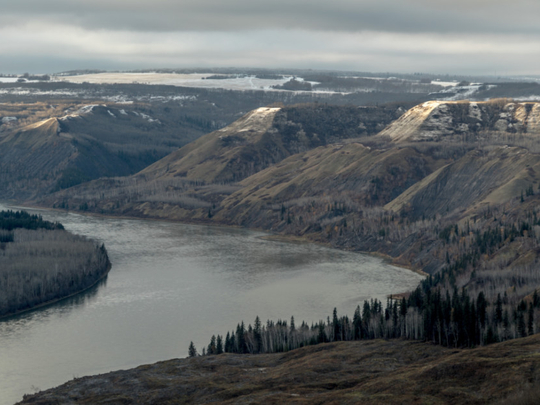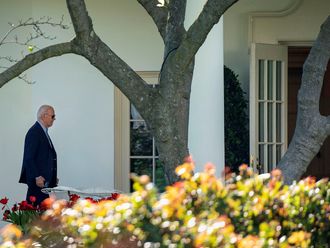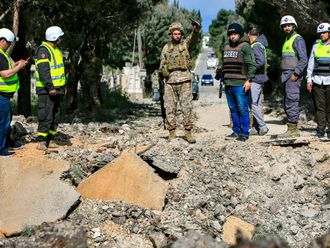
BEAR FLAT, British Columbia: Rugged, remote and prized for its rare microclimate, the Peace River Valley in northeastern British Columbia is an agricultural oasis in northern Canada.
Alfalfa, watermelon and barley fields sprawl across a landscape flecked by caribou tracks and seasonal trappers’ huts, which reflect the role indigenous peoples have played in this fertile land for more than 10,000 years.
But little of this abundance will be around much longer.
Within a decade, water will flood a 800-kilometre stretch of the river, the result of a $7 billion (Dh25 billion) hydroelectric dam and power station, known as Site C. It will be one of the largest public infrastructure projects in Canadian history.
The project has prompted mounting opposition and legal challenges from industry experts, former government officials, local landowners, aboriginal communities and others who say Site C poses a risk to the environment and violates constitutionally protected indigenous rights.
But opponents cite another simple reason the project should be stopped: After a decade of flat demand for electricity and the emergence of cheaper energy alternatives, the dam, they say, is an enormous boondoggle that will saddle taxpayers with huge debts for generations to come.
“You don’t even have to think very much about the environmental and aboriginal costs of Site C because the economics are so awful,” said Harry Swain, a former federal deputy minister and the chairman of a government environmental panel appointed to review the project.
The battle over Site C underscores a deeper conflict in Canada, with its image of tolerance and consensus: the struggle between a public demanding greater rights and a government trying to push through large projects while avoiding scrutiny, at least in the eyes of critics.
For the many people who will lose their property and livelihoods, the fight is more than one of principle.
Displacing residents
“BC Hydro said, ‘We’re building our dam, we’re taking your house and do you want to sign now or later?’”
Esther Pedersen said of British Columbia Hydro and Power Authority, known as BC Hydro, the provincial utility corporation behind the project. Her family will be forced off their land across the river from the dam project construction site.
The provincial government approved Site C in 2014, citing the province’s future energy needs — though even BC Hydro said that day might not arrive for another 40 years. Despite the welter of opposition, provincial officials exempted the project from independent regulatory scrutiny, allowing work to begin last year — and turning the project into a major point of contention in the provincial election in May.
Site C, which would be the third dam on the 1,770km Peace River, was first proposed by BC Hydro in the early 1980s. It was scuttled after the British Columbia Utilities Commission, the province’s independent public utility regulator, opposed the project because of doubts about the company’s demand forecasts. The commission also cited insufficient exploration into alternatives such as geothermal energy. A decade later, BC Hydro again shelved Site C after deeming that the power was still not needed, according to company documents.
Undeterred, BC Hydro and the provincial government, under the conservative British Columbia Liberal Party, revived the megaproject around a decade ago. The dam, they said, would produce enough energy to power 450,000 homes and would meet what they contend will be a 40 per cent increase in demand over the next two decades fuelled by a growing population.
Exporting electricity
But the government has also suggested that Site C electricity could power the province’s struggling liquefied natural gas industry, and then made a proposal to export the electricity to the neighbouring province of Alberta.
Opponents said the government’s series of justifications for the project showed there was no actual need or market for Site C.
No one disputes that electric bills will go up to pay for the project, which would not be paid off by provincial residents until 2094, at the earliest.
In its 2014 report on Site C, a joint federal-provincial panel concluded that BC Hydro “has not fully demonstrated the need for the project on the timetable set forth”, and recommended that the project be reviewed by the province’s independent utility commission.
But the cabinet of Christy Clark, the premier of British Columbia, blocked Site C from the commission’s review and has since poured billions of dollars into construction and contracts despite multiple lawsuits seeking to stop the project.
In an interview, William Bennett, the provincial minister of energy and mines, dismissed criticism of Site C and said that the project was vital to ensuring reliable, cheap power for a province facing a projected population growth of 1 million people over the next 20 years.
Bennett said the government exempted the project from the commission review because that watchdog group lacked the necessary resources and expertise. Instead, he said, the government hired “totally independent” private companies to review the project.
Among the companies hired to review and design the project were the accounting firm KPMG, which has donated more than 330,000 Canadian dollars to Bennett’s British Columbia Liberal party, and SNC-Lavalin, a Canadian engineering firm that has been imbued in corruption and bribery scandals and faced sanctions by the World Bank.
Opponents of Site C said that even if the electricity was needed in the future, the province has cheaper and less destructive alternatives.
These include renewable energy, like geothermal and electricity that the province can get through the Columbia River Treaty, which entitles British Columbia to use the power it currently sells to the US.
The project took on national significance under Prime Minister Justin Trudeau, who called treaty rights a “sacred obligation” that Canada must uphold.
During his campaign last year, Trudeau promised a “renewed, nation-to-nation relationship” with Canada’s indigenous peoples.
But last summer, the federal government granted permits that authorised BC Hydro to escalate the project.
After indigenous groups sought a judicial review, the federal government claimed it was not legally obligated to consider the issue of treaty rights relating to Site C, and demanded that the groups prove their case in court, a process that experts said would most likely not conclude before the flooding occurred in 2024.
— AP












